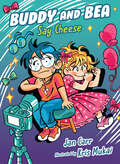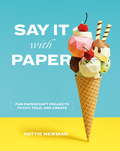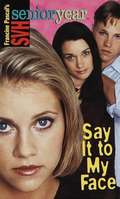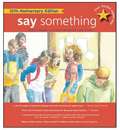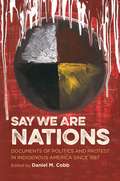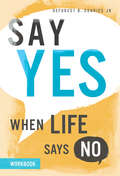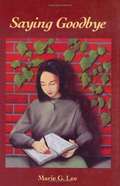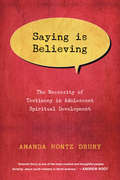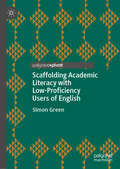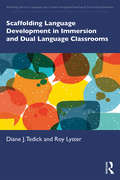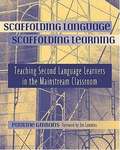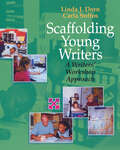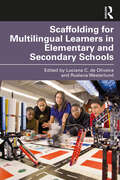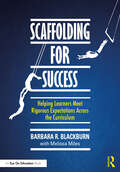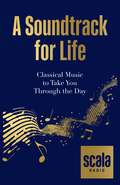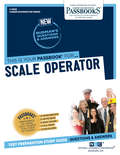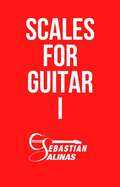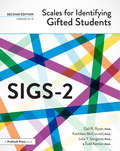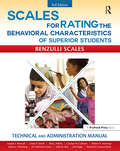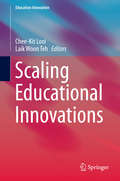- Table View
- List View
Say 'No' to Exam Stress: The Easy to Use Programme to Survive Exam Nerves
by Anthony JamesExams are important. The results can change lives and stressing about them can damage performance and undermine young peoples' confidence. This exam stress management programme requires very little time or effort to use and provides a straightforward, practical guide to exam stress management. Written by an experienced educational psychologist, this short, explanatory book is accompanied by simple, easy to follow audio files which lead the listener through a sequence of five relaxation sessions to reduce stress, increase focus and plan for success. Using the book as a guide you simply listen to the audio tracks and follow what they say. All tracks have been designed so that they are easy to digest and applicable in the middle of a busy day. To sum up, this book:• Provides practical and easy to follow steps to help anyone cope with exam stress• Teaches relaxation techniques that can be used to reduce stress wherever you find it • Offers a real stress knowledge base to teachers and family members supporting students with exam stressThis important guide is suitable for secondary school students as well as college and university students. The easy to follow relaxation sessions will be of interest to anyone studying for examinations who wishes to lower their exam stress levels.
Say Cheese (Buddy and Bea #4)
by Jan Carr&“Boisterous&” and &“bustling&” Buddy and Bea make some unexpected—and hilarious—memories on school picture day in the fourth book of this high-energy series.It&’s picture day at school! Lots of people are dressed up, and Bea is even wearing a fluffy dress, which she&’s not exactly excited about. When she tells Buddy that he should take his glasses off for the photo, he listens. But then, the glasses go missing. Are they lost? Did someone take them? Bea volunteers to find them, even though Buddy isn't sure he wants Bea to &“help.&”This funny and fast-paced series stars a hilariously unlikely buddy duo, making it irresistible to chapter book readers.
Say Her Name
by Juno DawsonDrip...drip...drip... In five days, she will come...Drip...drip...drip... In five days, she will come... Roberta 'Bobbie' Rowe is not the kind of person who believes in ghosts. A Halloween dare at her ridiculously spooky boarding school is no big deal, especially when her best friend Naya and cute local boy Caine agree to join in too. They are ordered to summon the legendary ghost of Bloody Mary: say her name five times in front of a candlelit mirror, and she shall appear... But, surprise surprise, nothing happens. Or does it? Next morning, Bobbie finds a message on her bathroom mirror - five days - but what does it mean? And who left it there? Things get increasingly weird and more terrifying for Bobbie and Naya, until it becomes all too clear that Bloody Mary was indeed called from the afterlife that night, and she is definitely not a friendly ghost. Bobbie, Naya and Caine are now in a race against time before their five days are up and Mary comes for them, as she has come for countless others before... A truly spine-chilling yet witty horror from shortlisted 'Queen of Teen' author James Dawson.
Say It With Paper: Fun papercraft projects to cut, fold and create
by Hattie NewmanThere are many things you can do with paper but what can paper do for you?Discover paper's true potential with this book full of exciting projects that enable you to discover new paper arts, such as pop ups, papercuts and 3-D shapes. Learn how paper can be used to communicate ideas, how it can be photographed and lit to great effect and even how it can be animated. Develop skills in construction, tessellation, model making and scene creating, while also working with scale and moving parts. Paper has never been more fun and more intriguing. Projects include: animal masks, ice creams, shadow puppets, tropical island, Ferris wheel, 3-D pig, car, lantern, geometric mobile, paper food, pop-up greetings card, paper theatre, giant pencil, and many more.
Say It to My Face (Sweet Valley High Senior Year #2)
by Francine PascalRumors are flying -- about Jessica. The year is off to a terrible start for Jessica Wakefield. Lies about her fly around school, and her friends seem to believe the rumors. How could anyone think that she would actually do THAT with HIM -- the biggest jerk at El Carro high?
Say Something
by Lea Lyon Peggy MossAt this school, there are some children who push and tease and bully. Sometimes they hurt other kids by just ignoring them. The girl in this story sees it happening, but she would never do these mean things herself. Then one day something happens that shows her that being a silent bystander isn't enough. Will she take some steps on her own to help another kid? Bright, fluid, realistic watercolors illustrate the story, set in a school with lots of diversity. <P> Resources at the end of the book will help parents and children talk about teasing and bullying and find ways to stop it at school. One child at a time can help change a school.
Say We Are Nations
by Daniel M. CobbIn this wide-ranging and carefully curated anthology, Daniel M. Cobb presents the words of Indigenous people who have shaped Native American rights movements from the late nineteenth century through the present day. Presenting essays, letters, interviews, speeches, government documents, and other testimony, Cobb shows how tribal leaders, intellectuals, and activists deployed a variety of protest methods over more than a century to demand Indigenous sovereignty. As these documents show, Native peoples have adopted a wide range of strategies in this struggle, invoking "American" and global democratic ideas about citizenship, freedom, justice, consent of the governed, representation, and personal and civil liberties while investing them with indigenized meanings.The more than fifty documents gathered here are organized chronologically and thematically for ease in classroom and research use. They address the aspirations of Indigenous nations and individuals within Canada, Hawaii, and Alaska as well as the continental United States, placing their activism in both national and international contexts. The collection's topical breadth, analytical framework, and emphasis on unpublished materials offer students and scholars new sources with which to engage and explore American Indian thought and political action.
Say Yes When Life Says No Workbook
by Dr. DeForest B. Soaries Jr.Turn life’s nos into yeses The companion workbook to Say Yes When Life Says No is an exciting and encouraging 31-day guide that restarts dreams and goals that seem out of reach. With insightful anecdotes and moving biblical references from Rev. Dr. DeForest Soaries, this hands-on workbook encourages us to dig in and work toward setting personal goals, completing daily action items, and gaining clarity on reflective questions that will ignite our potential and move our response from “no” to “yes!” You will address key areas like:Your dream jobFinancial freedomYour life’s missionCompanionshipHealthLife, death, and moreIntended to be filled out alongside the compelling trade book, this workbook is engaging, thought-provoking, and inspirational. Although overcoming life challenges is daunting, this workbook will help each of us to see the value and vision of life as revealed in the Bible.
Saying Goodbye
by Marie G. LeeIn this sequel to "Finding My Voice," Ellen Sung explores her interest in creative writing and in her Korean heritage during her freshman year at Harvard.
Saying Is Believing: The Necessity of Testimony in Adolescent Spiritual Development
by Amanda Hontz Drury"I have seen and I testify . . ." (John 1:34) The idea of giving one's testimony often evokes summer church camps, evangelistic revivals, mission trips and baptisms. Like an eyewitness called to testify in a courtroom, sharing a testimony of faith is for specific people at special moments. But what if our view of testimony is all wrong? According to Amanda Drury, testimony is not merely about describing something that happened in the past. It is a practice that forms our present and future identity. Testimony changes us, and without it we risk having a stunted and stale faith. Drawing on work in sociology, psychology and theology, Drury develops an understanding of testimony as an essential practice for Christian spiritual formation, especially for adolescents who are in the process of developing their identity. Recent studies reveal a staggering inability for adolescents to articulate their religious beliefs. Now more than ever, churches need to recover the practice of testimony as an integral part of communal worship.
Scaffolding Academic Literacy with Low-Proficiency Users of English
by Simon GreenThis book analyses the development of academic literacy in low-proficiency users of English in the Middle East. It highlights the challenges faced by students entering undergraduate education in the region, and the strategies used by teachers to overcome them. The author focuses on a large-scale undergraduate teacher programme run in Oman by the University of Leeds, providing clear pointers both for future research and effective practice. He also explores the implications of his findings for countries beyond the Gulf Cooperation Council, demonstrating how international participation in UK HE could be much wider. This book will appeal to students and scholars with an interest in academic literacies and English for Academic Purposes.
Scaffolding Language
by Pauline GibbonsThe bestselling Scaffolding Language, Scaffolding Learning helped tens of thousands of mainstream elementary teachers ensure that their English language learners became full members of the school community with the language and content skills they needed for success. In the highly anticipated Second Edition, Pauline Gibbons updates her classic text with a multitude of practical ideas for the classroom, supported by the latest research in the field of ELL/ESL. With clear directions and classroom tested strategies for supporting students' academic progress, Gibbons shows how the teaching of language can be integrated seamlessly with the teaching of content, and how academic achievement can be boosted without sacrificing our own vision of education to the dictates of knee-jerk accountability. Rich examples of classroom discourse illustrate exactly how the scaffolding process works, while activities to facilitate conversation and higher-level thinking put the latest research on second language learning into action.
Scaffolding Language Development in Immersion and Dual Language Classrooms (Routledge Series in Language and Content Integrated Teaching & Plurilingual Education)
by Roy Lyster Diane J. TedickThis book introduces research-based pedagogical practices for supporting and enhancing language development and use in school-based immersion and dual language programs in which a second, foreign, heritage, or indigenous language is used as the medium of subject-matter instruction. Using counterbalanced instruction as the volume’s pedagogical framework, the authors map out the specific pedagogical skill set and knowledge base that teachers in immersion and dual language classrooms need so their students can engage with content taught through an additional language while continuing to improve their proficiency in that language. To illustrate key concepts and effective practices, the authors draw on classroom-based research and include teacher-created examples of classroom application. The following topics are covered in detail: defining characteristics of immersion and dual language programs and features of well-implemented programs strategies to promote language and content integration in curricular planning as well as classroom instruction and performance assessment an instructional model to counterbalance form-focused and content-based instruction scaffolding strategies that support students’ comprehension and production while ensuring continued language development an approach to creating cross-linguistic connections through biliteracy instruction a self-assessment tool for teachers to reflect on their pedagogical growth Also applicable to content and language integrated learning and other forms of content-based language teaching, this comprehensive volume includes graphics to facilitate navigation and provides Resources for Readers and Application Activities at the end of each chapter. The book will be a key resource for preservice and in-service teachers, administrators, and teacher educators.
Scaffolding Language, Scaffolding Learning: Teaching Second Language Learners in the Mainstream Classroom
by Jim Cummins Pauline GibbonsHow does a mainstream elementary classroom teacher with little or no specialized ESL training meet the challenge of teaching linguistically diverse students? Pauline Gibbons suggests how: integrate the teaching of English with the content areas of the regular curriculum. What's more, she shows how in this practical resource book. Gibbons begins with a strong theoretical underpinning for her practice, drawing on a functional model of language, sociocultural theories of learning, and current research on second-language development. After supporting her view that the regular curriculum offers the best language-learning environment for young ESL students, Gibbons demonstrates the ways in which content areas provide a context for the teaching of English, from speaking and listening to reading and writing. These in turn are treated not as discrete skills, but as ones that can also be integrated in the learning of diverse subjects. Gibbons illustrates this with a wide range of teaching and learning activities across the curriculum, supplemented with programming and assessment formats and checklists. Language learning is not a simple linear process, but involves the ongoing development of skills for a range of purposes. Gibbons sees this development as largely the result of the social contexts and interactions in which learning occurs. By focusing on the ways in which teachers can "scaffold" language and learning in the content areas, she takes a holistic approach-one that appreciates the struggle of students learning a new language, while simultaneously developing subject knowledge in it, and the challenge for teachers to address these needs. Given today's culturally and linguistically diverse classrooms, ESL students can no longer be thought of as a group apart from the mainstream-they are. the mainstream. This book describes the ways to ensure that ESL learners become full members of the school community with the language and content skills they need for success.
Scaffolding Young Writers: A Writer's Workshop Approach
by Linda Dorn Carla SoffosThe goal of teaching writing is to create independent and self-motivated writers. When students write more often, they become better at writing. They acquire habits, skills, and strategies that enable them to learn more about the craft of writing. Yet they require the guidance and support of a more knowledgeable person who understands the writing process, the changes over time in writing development, and specific techniques and procedures for teaching writing. In Scaffolding Young Writers: A Writers' Workshop Approach , Linda J. Dorn and Carla Soffos present a clear road map for implementing writers' workshop in the primary grades. Adopting an apprenticeship approach, the authors show how explicit teaching, good models, clear demonstrations, established routines, assisted teaching followed by independent practice, and self-regulated learning are all fundamental in establishing a successful writers' workshop. There is a detailed chapter on organizing for writers' workshop, including materials, components, routines, and procedures. Other chapters provide explicit guidelines for designing productive mini-lessons and student conferences. Scaffolding Young Writers also features: An overview of how children become writers; Analyses of students' samples according to informal and formal writing assessments Writing checklists, benchmark behaviors, and rubrics based on national standards Examples of teaching interactions during mini-lessons and writing conferences Illustrations of completed forms and checklists with detailed descriptions, and blank reproducible forms in the appendix for classroom use Instruction is linked with assessment throughout the book, so that all teaching interactions are grounded in what children already know and what they need to know as they develop into independent writers.
Scaffolding for Multilingual Learners in Elementary and Secondary Schools
by Luciana C. de Oliveira Ruslana WesterlundThis insightful and timely volume addresses how scaffolding can be used to support multilingual learners to amplify their opportunities for learning. As a dynamic educational process, scaffolding facilitates responsive and adaptive teaching and learning; addresses students’ needs; increases student autonomy; and promotes adaptive, high-level learning without simplifying instruction. Section I covers the theoretical grounding and reconceptualizations of scaffolding. Section II offers concrete examples and case studies from varied classroom contexts. Section III provides a window into professional development to discuss the work of pre-service and in-service teachers, and how they develop their understandings and practices of teaching multilingual learners. Contributors address diverse topics, including translanguaging in the classroom, scaffolding as a tool for equitable teaching, virtual learning, as well learning in dual language and content area classrooms. Featuring examples from teacher education programs as well as principles for design of educative curriculum materials, this book is ideal for pre-service teachers and students in TESOL, applied linguistics, and language education.
Scaffolding for Success: Helping Learners Meet Rigorous Expectations Across the Curriculum
by Barbara R. BlackburnSupport and scaffolding are critical for moving students to higher levels of learning. But how do we ensure we’re giving the “right” work and not just extra work? Barbara R. Blackburn has the answers in this important new book. She provides a plethora of strategies for helping students create meaning and become more independent so they can truly learn at rigorous levels.First, she examines the basics of rigor and scaffolding and uncovers the role of planning in scaffolding, including the difference between acceleration and remediation and examples of differentiating instruction with scaffolding. Then she demonstrates a variety of ways to add scaffolding into classroom discourse, vocabulary, comprehension, and writing across the curriculum. Ideas and strategies are provided for different subject areas and levels, so you can easily apply them to your own setting. And finally, she shows the roles of formative assessment and social emotional learning in scaffolding.With this practical book, you’ll have a toolkit of great ideas at your disposal as you foster a learning environment of high expectations and success.
Scala Radio's A Soundtrack for Life: Classical Music to Take You Through the Day
by Scala RadioBringing together much-loved masterpieces with exciting new works, this accessible and inspiring guide is a celebration of classical music. With pieces ranging from Vaughan Williams's The Lark Ascending and Beethoven's Pastoral Symphony to the scores for Avatar and Assassin's Creed, each entry puts the piece of music into context, providing fascinating insights into the inspirations behind each work and enhancing your listening experience. Organised into Occasions and Themes, the book features music to accompany you through your day, from getting up and getting dressed to running, reading, walking the dog, cooking, taking a bath, going to sleep and everything in between. You'll also find expert curations of the world's most romantic music and the greatest Christmas choral works as well as compositions that celebrate the natural world and mark births and marriages. Perfect for classical music enthusiasts as well as anyone looking for an enjoyable introduction to this genre, this is the definitive modern guide to classical music.
Scala Radio's A Soundtrack for Life: Classical Music to Take You Through the Day
by Scala RadioBringing together much-loved masterpieces with exciting new works, this accessible and inspiring guide is a celebration of classical music. With pieces ranging from Vaughan Williams's The Lark Ascending and Beethoven's Pastoral Symphony to the scores for Avatar and Assassin's Creed, each entry puts the piece of music into context, providing fascinating insights into the inspirations behind each work and enhancing your listening experience. Organised into Occasions and Themes, the book features music to accompany you through your day, from getting up and getting dressed to running, reading, walking the dog, cooking, taking a bath, going to sleep and everything in between. You'll also find expert curations of the world's most romantic music and the greatest Christmas choral works as well as compositions that celebrate the natural world and mark births and marriages. Perfect for classical music enthusiasts as well as anyone looking for an enjoyable introduction to this genre, this is the definitive modern guide to classical music.
Scale Operator: Passbooks Study Guide (Career Examination Series)
by National Learning CorporationThe Scale Operator Passbook® prepares you for your test by allowing you to take practice exams in the subjects you need to study. It provides hundreds of questions and answers in the areas that will likely be covered on your upcoming exam, including but not limited to: Understanding and interpreting written material including procedures; Comparing and verifying alpha and numeric characters; Arithmetic reasoning; Ability to interact with the public in a courteous manner; and more.
Scale: Imagination, Perception and Practice in Architecture
by Gerald Adler Gordana Fontana-Giusti Timothy Brittain-CatlinScale is a word which underlies much of architectural and urban design practice, its history and theory, and its technology. Its connotations have traditionally been linked with the humanities, in the sense of relating to human societies and to human form. ‘To build in scale’ is an aspiration that is usually taken for granted by most of those involved in architectural production, as well as by members of the public; yet in a world where value systems of all kinds are being questioned, the term has come under renewed scrutiny. The older, more particular, meanings in the humanities, pertaining to classical Western culture, are where the sense of scale often resides in cultural production. Scale may be traced back, ultimately, to the discovery of musical harmonies, and in the arithmetic proportional relationship of the building to its parts. One might question the continued relevance of this understanding of scale in the global world of today. What, in other words, is culturally specific about scale? And what does scale mean in a world where an intuitive, visual understanding is often undermined or superseded by other senses, or by hyper-reality? Structured thematically in three parts, this book addresses various issues of scale. The book includes an introduction which sets the scene in terms of current architectural discourse and also contains a visual essay in each section. It is of interest to undergraduate and postgraduate students, academics and practitioners in architecture and architectural theory as well as to students in a range of other disciplines including art history and theory, geography, anthropology and landscape architecture.
Scales for Guitar I
by Sebastian SalinasScales for Guitar I presents exercises to help you easily learn the major and minor pentatonic and diatonic scales. Learning the scales on a guitar is of the utmost importance for your skills of improvisation and composition. Each of the four scales covered in this book are shown in five positions on the fretboard of the guitar. The goal is that you will know and immediately see all five positions as a single great pattern that covers all strings on your guitar. Practicing these scales in the five positions will give you a deeper understanding of the fretboard and thus improve your guitar playing skills.
Scales for Identifying Gifted Students (SIGS-2): Examiner's Manual
by Kathleen McConnell Gail R. Ryser Laila Y. SangurasScales for Identifying Gifted Students–Second Edition (SIGS-2) offers the most comprehensive observational instrument available for identifying gifted students grades K–12. Used as part of a comprehensive process for identifying gifted children, SIGS-2 offers schools an instrument with extensive statistical and research support.
Scales for Rating the Behavioral Characteristics of Superior Students: Technical and Administration Manual
by Joseph RenzulliThis is the Technical and Administration Manual for the Scales for Rating the Behavioral Characteristics of Superior Students.The Scales for Rating the Behavioral Characteristics of Superior Students are commonly referred to as the Renzulli Scales orRenzulli-Hartman Scales.Now in its third edition, the Renzulli Scales are the nation's most popular tool for identifying gifted children. Supported by 40 years of research, the Renzulli Scales are used by gifted and talented programs across the country. This standardized instrument is completed by teachers and provides an effective method for identifying gifted children. The Scales for Rating the Behavioral Characteristics of Superior Students: Technical and Administration Manual includes technical information about how the scales were developed as well as guidelines for using the scales. The manual includes a review of the supporting research for the instrument, field test data, and construct validity support. The manual also includes in-depth information about administering the Renzulli Scales and interpreting the results.The manual features extensive appendices that include reproducible teacher training activities to help teachers understand how to use the scales and rate students, easy-to-follow instructions on how to establish local norms in a school or district, and a practical plan for identifying students for gifted and talented programs.The Renzulli Scales are designed to obtain teacher estimates of a student's characteristics in the following areas:Learning CharacteristicsCreativity CharacteristicsMotivation CharacteristicsLeadership CharacteristicsArtistic CharacteristicsMusical CharacteristicsDramatics CharacteristicsCommunication Characteristics (Precision)Communication Characteristics (Expressiveness)Planning CharacteristicsMathematics CharacteristicsReading CharacteristicsTechnology CharacteristicsScience CharacteristicsEach scale contains multiple items that are rated using a Likert-type scale. The first four scales (learning, creativity, motivation, and leadership) are used by most schools that use the Scales. The remaining 10 scales are focused on specific areas. They are used by schools when those areas seem appropriate for a gifted program's goals. For example, a program serving gifted math students would use the mathematics scale, a science academy would use the science scale, etc.Research shows that gifted children tend to exhibit certain observable behaviors, such as using advanced vocabulary, grasping underlying principles, and making generalizations from complex information. The Renzulli Scales asks teachers to rate children in comparison to their peers on a host of these observable behaviors. The children who score high on the scales are more likely to be gifted. Using a tool like the Scales, a school can narrow the number of students who will be fully evaluated for a gifted program.The items were chosen from a comprehensive body of research concerning the characteristics of gifted students. Based on a multiple talent approach to the identification of gifted students, the scales help identify student strengths.This is the Technical and Administration Manual only.
Scaling Educational Innovations
by Chee-Kit Looi Laik Woon TehThis volume stimulates critical discussions of the different variants of implementation, translation and scaling research approaches. It presents an integrated collection of different implementation and scaling studies that analyse the different facets of co-design, learning design, curriculum development, technology development, professional development and programme implementation. It also provides critical reflections on their impact and efficacies on transforming practices, informing policy-making, and theory derivation and improvement. The chapters in this volume will provide readers a deeper understanding of scaling of educational innovations in diverse socio-cultural contexts.

